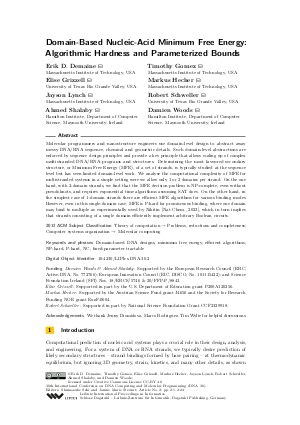LIPIcs.DNA.30.2.pdf
- Filesize: 1.06 MB
- 24 pages

 Creative Commons Attribution 4.0 International license
Creative Commons Attribution 4.0 International license

Molecular programmers and nanostructure engineers use domain-level design to abstract away messy DNA/RNA sequence, chemical and geometric details. Such domain-level abstractions are enforced by sequence design principles and provide a key principle that allows scaling up of complex multistranded DNA/RNA programs and structures. Determining the most favoured secondary structure, or Minimum Free Energy (MFE), of a set of strands, is typically studied at the sequence level but has seen limited domain-level work. We analyse the computational complexity of MFE for multistranded systems in a simple setting were we allow only 1 or 2 domains per strand. On the one hand, with 2-domain strands, we find that the MFE decision problem is NP-complete, even without pseudoknots, and requires exponential time algorithms assuming SAT does. On the other hand, in the simplest case of 1-domain strands there are efficient MFE algorithms for various binding modes. However, even in this single-domain case, MFE is P-hard for promiscuous binding, where one domain may bind to multiple as experimentally used by Nikitin [Nat Chem., 2023], which in turn implies that strands consisting of a single domain efficiently implement arbitrary Boolean circuits.
















































Feedback for Dagstuhl Publishing